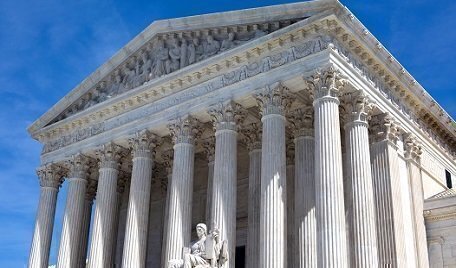A divided Supreme Court on Monday allowed the state of Ohio’s voter-registration list maintenance policies to remain in place, reversing a federal appeals court ruling.
 In the majority decision in Husted v. A. Philip Randolph Institute, Justice Samuel Alito said that Ohio’s process to remove voters using change-of-residence grounds didn’t violate the National Voter Registration Act (or NVRA). “Ohio’s process cannot be unreasonable because it uses the change-of-residence evidence that Congress said it could,” Alto concluded. “Ohio’s process is accordingly lawful.”
In the majority decision in Husted v. A. Philip Randolph Institute, Justice Samuel Alito said that Ohio’s process to remove voters using change-of-residence grounds didn’t violate the National Voter Registration Act (or NVRA). “Ohio’s process cannot be unreasonable because it uses the change-of-residence evidence that Congress said it could,” Alto concluded. “Ohio’s process is accordingly lawful.”
Chief Justice John Roberts and Associate Justices Anthony Kennedy, Clarence Thomas, and Neil Gorsuch joined Alito in the majority opinion.
“This case presents a question of statutory interpretation, not a question of policy. We have no authority to second-guess Congress or to decide whether Ohio’s Supplemental Process is the ideal method for keeping its voting rolls up to date,” Alito said.
Associate Justice Stephen Breyer wrote a dissenting opinion, as did Associate Justice Sonia Sotomayor. “Congress enacted the NVRA against the backdrop of substantial efforts by States to disenfranchise low-income and minority voters, including programs that purged eligible voters from registration lists because they failed to vote in prior elections,” said Sotomayor.
“The Court errs in ignoring this history and distorting the statutory text to arrive at a conclusion that not only is contrary to the plain language of the NVRA but also contradicts the essential purposes of the statute, ultimately sanctioning the very purging that Congress expressly sought to protect against,” she concluded.
In February 2017, Ohio Secretary of State Jon Husted filed a petition with the Supreme Court after the state lost a decision in the federal Sixth Circuit Appeals Court. Ohio argued that under the National Voter Registration Act of 1993 (or NVRA) and the Help America Vote Act of 2002 (or HAVA), it could start a “supplemental” process of voter purging for a person who “has not voted or appeared to vote in 2 or more consecutive general elections for Federal office.”
The Philip Randolph Institute challenged the state’s policy in 2016, claiming the voter-purging efforts eliminated a disproportionate number of lower-income and minority voters from the election process. It also contested Ohio’s interpretation of the federal laws that permitted voter inactivity as the “trigger” mechanism for maintaining voter rolls.
Scott Bomboy is the editor in chief of the National Constitution Center.







